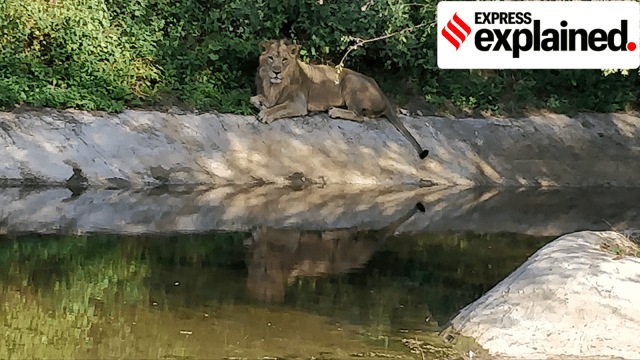On March 6, the Supreme Court said it was “inclined to approve the establishment of the Tiger Safari at Pakhrau” in the buffer area of Corbett tiger reserve. However, safari parks are meant only for “injured, conflicted, or orphaned” local tigers, and not those sourced from zoos, the court said, and constituted a committee to frame guidelines for such facilities within three months.
The court also gave CBI three months to complete its investigation into alleged irregularities inside the Corbett tiger reserve, as directed by the Uttarakhand High Court.

What does a “tiger safari” really mean?
Tiger safari is not defined under The Wildlife (Protection) Act, 1972 which says “no construction of commercial tourist lodges, hotels, zoos and safari parks shall be undertaken inside a sanctuary except with the prior approval of the National Board” [for Wild Life] constituted under the Act.
The concept of a tiger safari in the wild was first envisaged in the Guidelines for Tourism issued by the National Tiger Conservation Authority (NTCA) in 2012, which provided for such establishments in the buffer areas of tiger reserves “which experience immense tourist influx in the core/ critical tiger habitat for viewing tigers”.
Four years later, the NTCA issued guidelines to establish “Tiger Safaris” in the buffer and fringe areas of tiger reserves for injured, conflicted, or orphaned tigers, while underlining that no tiger shall be obtained from a zoo.
In 2019, however, the NTCA allowed animals to be brought from zoos for tiger safari parks, and gave the Central Zoo Authority (CZA) the power to select such animals.
Housing zoo tigers or other captive animals in a tiger habitat is obviously a bad idea, which would put wild tigers and other wildlife at risk of disease. Fittingly, the top court held that the NTCA’s understanding that tiger safaris are merely zoos built inside tiger reserves, “would be totally contrary to the purpose of the Tiger Conservation”.
Story continues below this ad
But why build a tiger safari in a forest?
The 2012 NTCA guidelines justified safari parks as a means to lessen the tourism load inside tiger reserves that causes stress on wildlife.
Second, many are against packing off animals that are unfit for the wild — they may be injured, orphaned, or given to conflict — to faraway zoos. Safari parks, they argue, help hold such animals captive in their natural surroundings.
Third, some stakeholders argue that buffer areas were designated to allow activities that support the livelihood and development needs of local communities — and safari parks generate money and, in turn, local goodwill for the tiger.
And what is the counter-argument?
Records show that efforts to distribute demand seldom work in tiger reserves. Instead of bringing down the number of vehicles crowding around the tiger, opening new safari routes have ended up inviting more tourists.
Story continues below this ad
Also, the very idea of displaying “rescued” tigers in safari parks is a departure from the practice of keeping such distressed animals in non-display facilities. Even the 2016 guidelines were hesitant to make this policy shift, and made it mandatory for NTCA to assess every “recovered/ treated animal” before putting them on display in safari parks.
Third, housing local “rescued” wildlife in their natural environment is an idea driven by concerns for animal welfare. But conservationists say a captive animal will be captive anywhere. They argue that building safari parks for “rescued” tigers inside tiger reserves prioritises the welfare of individual tigers over the interest of the species, since such establishments are bound to cause disturbance in wild habitats.
What is the ground reality in Corbett and elsewhere?
The site selected for the Pakhrau Safari Park is on the southwestern fringe of Corbett Tiger Reserve, bordering farmlands in Uttar Pradesh. Uttarakhand forest department officers argue that the dispersal of tigers and other wildlife to the west towards Rajaji tiger reserve happens mostly to the north of the proposed safari park, which can be accessed by an existing forest road, and will not require the cutting of trees.
Some local stakeholders say that the Ramnagar area on the eastern side of the reserve has hogged all the benefits of Corbett’s tiger tourism so far — and the Pakhrau Safari Park carries the promise of livelihood and development on the other side.
Story continues below this ad
However, the experience in Ranthambhore in Rajasthan raises some cautionary flags. In 2015-16, a safari park for rescued tigers was envisaged there with the intention of lessening the tourism load and aiding local livelihoods. The project has so far seen multiple attempts at constructing peripheral walls, which have, however, collapsed repeatedly, necessitating fresh work orders every time.
Before the SC drew the line on zoo animals this week, a number of safari parks inside protected forests stocked a range of zoo collections. For example, the Nahargarh Biological Park, a part of Nahargarh sanctuary on the Jaipur-Delhi highway, which was inaugurated in 2016, has Asiatic lions, Royal Bengal tigers, panthers, hyenas, wolves, deer, crocodiles, sloth bears, Himalayan black bears, etc.
However, introducing animals in permanent facilities built in the wild invariably creates stress for territorial species — and the resident leopards in Nahargarh often reacted aggressively to the captive ones housed in the safari park.
So what is the road ahead for safari parks in tiger reserves?
The guidelines for tiger safari parks are awaited from the SC-appointed expert committee. However, a one-size-fits-all formula is unlikely to be helpful, senior state forest officials cautioned. The more prudent approach would be to lay down guiding principles for local authorities to find site-specific solutions, they said.
Story continues below this ad
It is also important to avoid the temptation of making tiger safari parks a routine feature of tiger reserves, experts said. The 2016 guidelines had said that a tiger safari can be proposed only by tiger reserves that have already utilised 100% of their tourist carrying capacity.








































